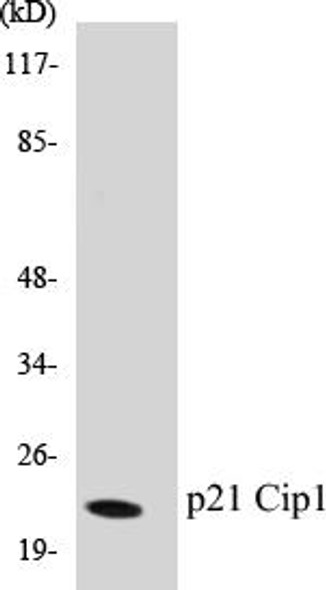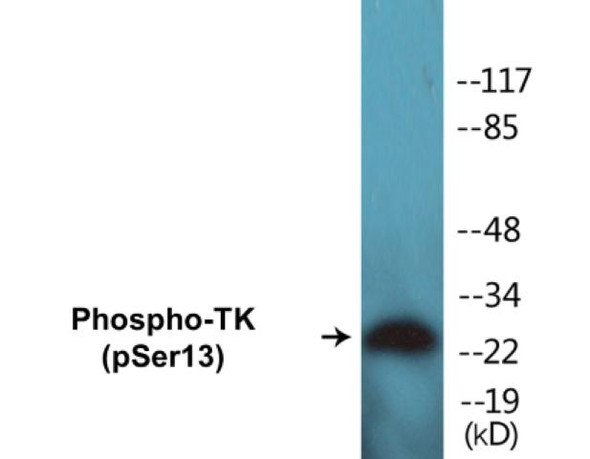Description
p21 Cip1 (Phospho-Thr145)Colorimetric Cell-Based ELISA Kit
The p21/Cip1 Phospho-Thr145 Colorimetric Cell-Based ELISA Kit is a highly sensitive and specific assay designed for the quantitative detection of phosphorylated p21/Cip1 protein levels in cell lysates. This kit is suitable for research applications focused on understanding the role of p21/Cip1 in cell cycle regulation, DNA damage response, and tumor suppression.The phosphorylation of threonine 145 on p21/Cip1 protein plays a critical role in regulating its stability and function, making it an important marker for studying cell cycle progression and cancer development.
By accurately measuring phosphorylated p21/Cip1 levels, researchers can gain valuable insights into the mechanisms underlying these processes and identify potential therapeutic targets.With its user-friendly protocol and reliable performance, the p21/Cip1 Phospho-Thr145 Colorimetric Cell-Based ELISA Kit is an essential tool for scientists conducting cutting-edge research in the fields of cell biology, oncology, and drug discovery. Order yours today and unlock the potential of p21/Cip1 as a key player in cellular signaling pathways and disease mechanisms.
| Product Name: | p21 Cip1 (Phospho-Thr145)Colorimetric Cell-Based ELISA Kit |
| Product Code: | CBCAB01583 |
| ELISA Type: | Cell-Based |
| Target: | p21 Cip1 (Phospho-Thr145) |
| Reactivity: | Human, Mouse, Rat |
| Dynamic Range: | > 5000 Cells |
| Detection Method: | Colorimetric 450 nm |
| Format: | 2 x 96-Well Microplates |
The p21 Cip1 (Phospho-Thr145) Colorimetric Cell-Based ELISA Kit is a convenient, lysate-free, high throughput and sensitive assay kit that can detect p21 Cip1 protein phosphorylation and expression profile in cells. The kit can be used for measuring the relative amounts of phosphorylated p21 Cip1 in cultured cells as well as screening for the effects that various treatments, inhibitors (ie. siRNA or chemicals), or activators have on p21 Cip1 phosphorylation.
Qualitative determination of p21 Cip1 (Phospho-Thr145) concentration is achieved by an indirect ELISA format. In essence, p21 Cip1 (Phospho-Thr145) is captured by p21 Cip1 (Phospho-Thr145)-specific primary (1ø) antibodies while the HRP-conjugated secondary (2ø) antibodies bind the Fc region of the 1ø antibody. Through this binding, the HRP enzyme conjugated to the 2ø antibody can catalyze a colorimetric reaction upon substrate addition. Due to the qualitative nature of the Cell-Based ELISA, multiple normalization methods are needed:
| 1. | A monoclonal antibody specific for human GAPDH is included to serve as an internal positive control in normalizing the target absorbance values. |
| 2. | Following the colorimetric measurement of HRP activity via substrate addition, the Crystal Violet whole-cell staining method may be used to determine cell density. After staining, the results can be analysed by normalizing the absorbance values to cell amounts, by which the plating difference can be adjusted. |
| Database Information: | Gene ID: 1026, UniProt ID: P38936, OMIM: 116899, Unigene: Hs.370771 |
| Gene Symbol: | CDKN1A |
| Sub Type: | Phospho |
| UniProt Protein Function: | p21Cip1: a cell-cycle regulatory protein that Interacts with cyclin-CDK2 and -CDK4, inhibiting cell cycle progression at G1. Its expression is tightly controlled by p53, through which this protein mediates the p53-dependent cell cycle arrest at G1 phase. |
| UniProt Protein Details: | Protein type:Inhibitor; Cell cycle regulation Chromosomal Location of Human Ortholog: 6p21.2 Cellular Component: cyclin-dependent protein kinase holoenzyme complex; cytosol; nucleoplasm; nucleus; perinuclear region of cytoplasm Molecular Function:cyclin binding; cyclin-dependent protein kinase activating kinase activity; cyclin-dependent protein kinase inhibitor activity; metal ion binding; protein binding; protein complex binding; ubiquitin protein ligase binding Biological Process: cell cycle arrest; cellular response to amino acid starvation; cellular response to extracellular stimulus; DNA damage response, signal transduction by p53 class mediator resulting in cell cycle arrest; DNA damage response, signal transduction by p53 class mediator resulting in induction of apoptosis; epidermal growth factor receptor signaling pathway; fibroblast growth factor receptor signaling pathway; G1/S transition of mitotic cell cycle; G2/M transition of mitotic cell cycle; innate immune response; mitotic cell cycle; negative regulation of apoptosis; negative regulation of cell growth; negative regulation of cell proliferation; negative regulation of cyclin-dependent protein kinase activity; negative regulation of phosphorylation; nerve growth factor receptor signaling pathway; organ regeneration; phosphoinositide-mediated signaling; positive regulation of B cell proliferation; positive regulation of fibroblast proliferation; positive regulation of programmed cell death; Ras protein signal transduction; regulation of cyclin-dependent protein kinase activity; regulation of protein import into nucleus, translocation; response to arsenic; response to corticosterone stimulus; response to DNA damage stimulus; response to drug; response to hyperoxia; response to organic nitrogen; response to toxin; response to X-ray |
| NCBI Summary: | This gene encodes a potent cyclin-dependent kinase inhibitor. The encoded protein binds to and inhibits the activity of cyclin-cyclin-dependent kinase2 or -cyclin-dependent kinase4 complexes, and thus functions as a regulator of cell cycle progression at G1. The expression of this gene is tightly controlled by the tumor suppressor protein p53, through which this protein mediates the p53-dependent cell cycle G1 phase arrest in response to a variety of stress stimuli. This protein can interact with proliferating cell nuclear antigen, a DNA polymerase accessory factor, and plays a regulatory role in S phase DNA replication and DNA damage repair. This protein was reported to be specifically cleaved by CASP3-like caspases, which thus leads to a dramatic activation of cyclin-dependent kinase2, and may be instrumental in the execution of apoptosis following caspase activation. Mice that lack this gene have the ability to regenerate damaged or missing tissue. Multiple alternatively spliced variants have been found for this gene. [provided by RefSeq, Sep 2015] |
| UniProt Code: | P38936 |
| NCBI GenInfo Identifier: | 729143 |
| NCBI Gene ID: | 1026 |
| NCBI Accession: | P38936.3 |
| UniProt Secondary Accession: | P38936,Q14010, Q6FI05, Q9BUT4, |
| UniProt Related Accession: | P38936 |
| Molecular Weight: | 18,119 Da |
| NCBI Full Name: | Cyclin-dependent kinase inhibitor 1 |
| NCBI Synonym Full Names: | cyclin-dependent kinase inhibitor 1A |
| NCBI Official Symbol: | CDKN1A |
| NCBI Official Synonym Symbols: | P21; CIP1; SDI1; WAF1; CAP20; CDKN1; MDA-6; p21CIP1 |
| NCBI Protein Information: | cyclin-dependent kinase inhibitor 1 |
| UniProt Protein Name: | Cyclin-dependent kinase inhibitor 1 |
| UniProt Synonym Protein Names: | CDK-interacting protein 1; Melanoma differentiation-associated protein 6; MDA-6; p21 |
| Protein Family: | P21 prophage-derived protein |
| UniProt Gene Name: | CDKN1A |
| UniProt Entry Name: | CDN1A_HUMAN |
| Component | Quantity |
| 96-Well Cell Culture Clear-Bottom Microplate | 2 plates |
| 10X TBS | 24 mL |
| Quenching Buffer | 24 mL |
| Blocking Buffer | 50 mL |
| 15X Wash Buffer | 50 mL |
| Primary Antibody Diluent | 12 mL |
| 100x Anti-Phospho Target Antibody | 60 µL |
| 100x Anti-Target Antibody | 60 µL |
| Anti-GAPDH Antibody | 60 µL |
| HRP-Conjugated Anti-Rabbit IgG Antibody | 12 mL |
| HRP-Conjugated Anti-Mouse IgG Antibody | 12 mL |
| SDS Solution | 12 mL |
| Stop Solution | 24 mL |
| Ready-to-Use Substrate | 12 mL |
| Crystal Violet Solution | 12 mL |
| Adhesive Plate Seals | 2 seals |
The following materials and/or equipment are NOT provided in this kit but are necessary to successfully conduct the experiment:
- Microplate reader able to measure absorbance at 450 nm and/or 595 nm for Crystal Violet Cell Staining (Optional)
- Micropipettes with capability of measuring volumes ranging from 1 µL to 1 ml
- 37% formaldehyde (Sigma Cat# F-8775) or formaldehyde from other sources
- Squirt bottle, manifold dispenser, multichannel pipette reservoir or automated microplate washer
- Graph paper or computer software capable of generating or displaying logarithmic functions
- Absorbent papers or vacuum aspirator
- Test tubes or microfuge tubes capable of storing ≥1 ml
- Poly-L-Lysine (Sigma Cat# P4832 for suspension cells)
- Orbital shaker (optional)
- Deionized or sterile water
*Note: Protocols are specific to each batch/lot. For the correct instructions please follow the protocol included in your kit.
| Step | Procedure |
| 1. | Seed 200 µL of 20,000 adherent cells in culture medium in each well of a 96-well plate. The plates included in the kit are sterile and treated for cell culture. For suspension cells and loosely attached cells, coat the plates with 100 µL of 10 µg/ml Poly-L-Lysine (not included) to each well of a 96-well plate for 30 minutes at 37 °C prior to adding cells. |
| 2. | Incubate the cells for overnight at 37 °C, 5% CO2. |
| 3. | Treat the cells as desired. |
| 4. | Remove the cell culture medium and rinse with 200 µL of 1x TBS, twice. |
| 5. | Fix the cells by incubating with 100 µL of Fixing Solution for 20 minutes at room temperature. The 4% formaldehyde is used for adherent cells and 8% formaldehyde is used for suspension cells and loosely attached cells. |
| 6. | Remove the Fixing Solution and wash the plate 3 times with 200 µL 1x Wash Buffer for five minutes each time with gentle shaking on the orbital shaker. The plate can be stored at 4 °C for a week. |
| 7. | Add 100 µL of Quenching Buffer and incubate for 20 minutes at room temperature. |
| 8. | Wash the plate 3 times with 1x Wash Buffer for 5 minutes each time. |
| 9. | Add 200 µL of Blocking Buffer and incubate for 1 hour at room temperature. |
| 10. | Wash 3 times with 200 µL of 1x Wash Buffer for 5 minutes each time. |
| 11. | Add 50 µL of 1x primary antibodies Anti-p21 Cip1 (Phospho-Thr145) Antibody, Anti-p21 Cip1 Antibody and/or Anti-GAPDH Antibody) to the corresponding wells, cover with Parafilm and incubate for 16 hours (overnight) at 4 °C. If the target expression is known to be high, incubate for 2 hours at room temperature. |
| 12. | Wash 3 times with 200 µL of 1x Wash Buffer for 5 minutes each time. |
| 13. | Add 50 µL of 1x secondary antibodies (HRP-Conjugated AntiRabbit IgG Antibody or HRP-Conjugated Anti-Mouse IgG Antibody) to corresponding wells and incubate for 1.5 hours at room temperature. |
| 14. | Wash 3 times with 200 µL of 1x Wash Buffer for 5 minutes each time. |
| 15. | Add 50 µL of Ready-to-Use Substrate to each well and incubate for 30 minutes at room temperature in the dark. |
| 16. | Add 50 µL of Stop Solution to each well and read OD at 450 nm immediately using the microplate reader. |
(Additional Crystal Violet staining may be performed if desired – details of this may be found in the kit technical manual.)






